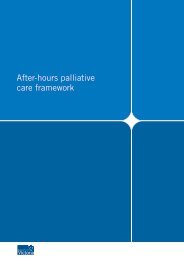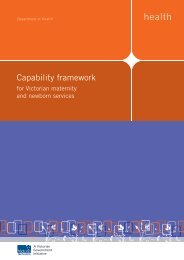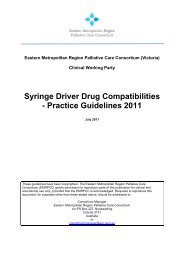CHEMOTHERAPY COMPETENCY ASSESSMENT
CHEMOTHERAPY COMPETENCY ASSESSMENT
CHEMOTHERAPY COMPETENCY ASSESSMENT
You also want an ePaper? Increase the reach of your titles
YUMPU automatically turns print PDFs into web optimized ePapers that Google loves.
<strong>CHEMOTHERAPY</strong><br />
<strong>COMPETENCY</strong> <strong>ASSESSMENT</strong><br />
OBJECTIVES<br />
Following formal training, practical experience and further reading, the participant<br />
will be able to:<br />
- Demonstrate an understanding of the principles of safe chemotherapy<br />
delivery for both patients and staff<br />
- Demonstrate the setting up, and use of technical equipment<br />
- Demonstrate an understanding of contraindications, possible complications<br />
and their treatment<br />
<strong>ASSESSMENT</strong> PROCESS<br />
- The participant will undergo the competency assessment one on one with an<br />
assessor<br />
- Satisfactory completion of the Gemini Competency and a familiarity with<br />
the IV infusion policy is required prior to undertaking this competency<br />
- On completion of the assessment the signed assessment form will be<br />
photocopied by the participant and given to the Unit Manager to be filed in<br />
personnel records<br />
TEACHING STRATEGIES<br />
Resources will include:<br />
- Chemotherapy manual<br />
- Clinical supervision<br />
- Peter MacCallum Chemotherapy Module 1 2001<br />
- Clinical Guidelines:<br />
- - Chemotherapy – Guidelines for Safe Handling and Administration<br />
ASSESSORS<br />
Assessments will be conducted by:<br />
- Melissa Duffin (AUM)<br />
- Sharon Scott (CNS)
PERFORMANCE CRITERIA:<br />
Demonstrate an understanding of the action of chemotherapy and identify crucial<br />
elements to be checked prior to its administration<br />
a) What is chemotherapy and briefly explain its action<br />
b) Identify the different routes of administration of chemotherapy<br />
-<br />
-<br />
-<br />
-<br />
-<br />
-<br />
3) Prior to the administration of chemotherapy, certain criteria must be met. Please<br />
identify these below<br />
-<br />
-<br />
-<br />
-<br />
-<br />
-<br />
-<br />
-
Demonstrate the correct procedure of administering a vesicant and include being able<br />
to identify a flare reaction and an extravasation. Also, identify what to do in the event<br />
of an extravasation, or where to obtain specific information on the treatment/antidote<br />
of an extravasated drug:<br />
a) Identify the three (3) groups that chemotherapy drugs are classed by<br />
-<br />
-<br />
-<br />
b) Demonstrate how an irritant or neutral drug is administered<br />
c) Demonstrate how a vesicant drug is administered<br />
-<br />
-<br />
d) Identify the difference between a flare and an extravasation<br />
e) Identify the actions to be taken in the event of a possible/probable<br />
extravasation or where the extravasation management policy can be<br />
found<br />
REFERENCES<br />
- Peter MacCallum Institute, Department of Nursing Education (2001)<br />
Chemotherapy Module 1<br />
- South West Healthcare Guidelines<br />
- Chemotherapy Competency Assessment (Feb 2004)<br />
PARTICIPANT:<br />
ASSESSOR:<br />
DATE:<br />
DATE:<br />
GRADE: SATISFACTORY / UNSATISFACTORY
CENTRAL VENOUS ACCESS DEVICE (CVAD)<br />
<strong>COMPETENCY</strong><br />
OBJECTIVES<br />
Following formal training, practical experience and further reading, the<br />
participant will be able to:<br />
- Demonstrate an understanding of the principles of portacaths, PICCS,<br />
hickman catheters and CVCs<br />
- Demonstrate knowledge of accessing, de-accessing and dressings of various<br />
CVADs<br />
- Demonstrate an understanding of contraindications, possible complications<br />
and their treatment<br />
<strong>ASSESSMENT</strong> PROCESS<br />
- The participant will undergo the competency assessment one on one with an<br />
assessor<br />
- On completion of the assessment, the signed assessment form will be<br />
photocopied by the participant and given to the Unit Manager to be filed in<br />
the personnel records<br />
TEACHING STRATEGIES<br />
Resources will include<br />
Clinical Guidelines<br />
- Central Venous Access Devices – Implanted Port Management 2010<br />
- Central Venous Access Devices – Short Term, PICCS, Hickmans 2010<br />
- Clinical supervision<br />
- Mandatory Update<br />
- Learning package available under Education on the Intranet
ASSESSORS:<br />
Assessments will be conducted by:<br />
- Melissa Duffin (AUM)<br />
- Sharon Scott (CNS)<br />
a) Explain the indications for the insertion of a CVAD<br />
b) Identify the different types of CVADS and their recommended usage<br />
period<br />
c) Post I/O a CVAD, tip position must be verified. How is this done?<br />
d) What is the recommended minimal syringe size to be used on any CVAD?<br />
e) In the event that a CVAD is unable to be bled or flushed, what process is<br />
required?<br />
f) In the event of a fracture, which catheter(s) can be repaired?<br />
(See SWH Graduate Program Competency)<br />
PARTICIPANT:<br />
ASSESSOR:<br />
DATE:<br />
DATE:<br />
GRADE: SATISFACTORY / UNSATISFACTORY<br />
REFERENCES:<br />
- Central Venous Access Devices – Implanted Port Management 2010<br />
- Central Venous Access Devices – Short Term, PICCs, Hickmans 2010<br />
- Southwest Healthcare Graduate Program<br />
o Central Venous Access Device Checklist (CVAD) 2008

















